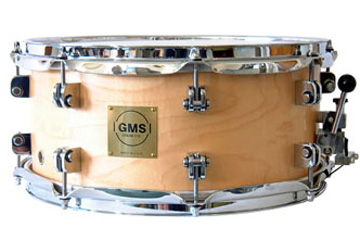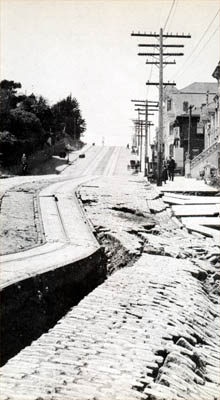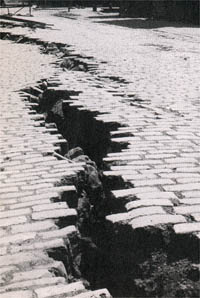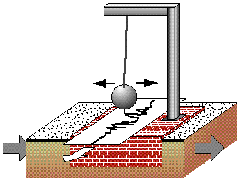Disaster 1906

I spent a few years working toward a Master's Degree in Instructional Technology at San Francisco State University. (even though I never finished the thesis). In the Fall semester of 2000 I built a little educational web site about the 1906 Earthquake & Fire in San Francisco.
It was a fun site to put together which included some information about earthquakes in general, some great photos, a few Quicktime movies (be patient, the files are quite large and may take a while to load), and and some links to the best books on the subject that I could find at the time. However, it was very limited by the tools, skills, and experience I had available at the time.
That site had been available online for a long time but I recently felt it was time for it to retire. This page contains the best elements that remain of that site.
I understand some recent research has concluded that much of our history of the 1906 earthquake may have been deceptively written to accommodate the City's need to have insurance companies pay for much of the rebuilding costs. If you have information about such research please contact me. I would love to hear more about it.
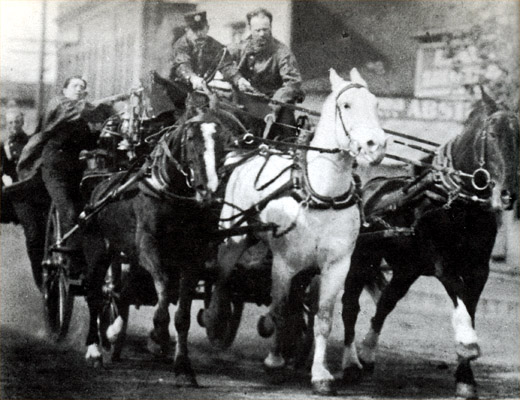
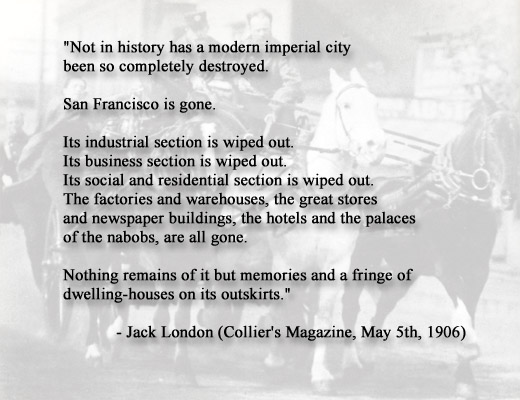
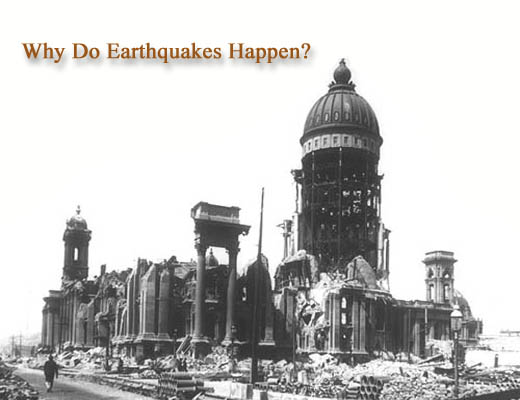
|
|
Earthquakes happen because the tectonic plates of the earth are in constant motion, sliding against each other. But they don't just slide smoothly; rocks catch against each other halting movment even though the plates are still in motion. Earthquakes occur when, eventually, the rocks break free and release the builtup the pressure along the fault line. This sudden release of energy causes the seismic waves that make the ground shake. The spot underground where the rock breaks is called the focus of the earthquake. The place right above the focus (on top of the ground) is called the epicenter.
|
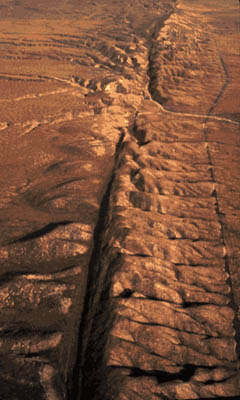 |
After the devastating 1906 San Francisco, California earthquake, a fault trace was discovered that could be followed along the ground in a more or less straight line for 270 miles. The earth on one side of the fault had slipped compared to the earth on the other side of the fault by up to 21 feet. Harry Fielding Reid, after studying the fault trace of the 1906 earthquake, concluded that the forces causing earthquakes were not close to the earthquake source but very distant. Reid's idea was that these distant forces cause a gradual build up of stress in the earth over tens or hundreds or thousands of years, slowly distorting the earth underneath our feet. Eventually, a pre-existing weakness in the earth--called a fault or a fault zone--can not resist the strain any longer and fails catastrophically. This is something like pulling a rubber band gradually until the band snaps. This theory is known as the "elastic rebound theory." |
|
|
Fault is a geological term for a fracture in the rocks of the Earth's crust. Where compressional or tensional forces cause the rocks on the opposite sides of the fracture, or fault, to be displaced relative to each other. Faults range in length from a few centimeters to many hundred kilometers, and displacement likewise may range from less than a centimeter to several hundred kilometers along the fracture surface. Faults may be vertical, horizontal, or inclined at any angle. Movement of rock along a fault may occur as a continuous creep or as a series of spasmodic jumps of a few meters during a few seconds. Such jumps are separated by intervals during which stress builds up until it overcomes the frictional forces along the fault plane. Most, if not all, earthquakes are caused by rapid movement along faults.
|
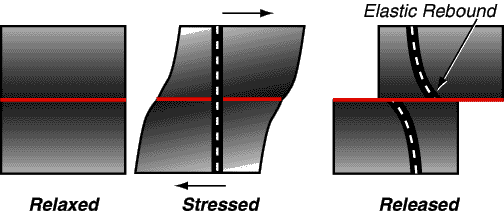 |
|
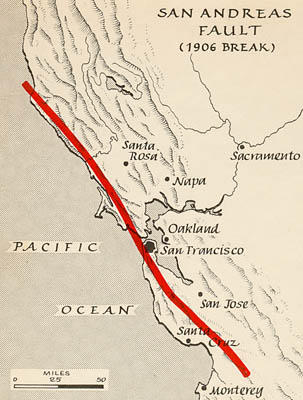
|
San Andreas Fault Measurements of triangulation lines across the San Andreas Fault before and after its rupture in the 1906 San Francisco earthquake led to the so-called elastic rebound theory for tectonic earthquakes. As formulated by the American geologist Harry Fielding Reid, the theory explains that a tectonic earthquake occurs when stresses in rock masses have accumulated to a point where they exceed the strength of the rocks, leading to rapid fracture. These rock fractures usually tend in the same direction and may extend over many kilometers along the zone of weakness. In the 1906 earthquake the San Andreas Fault slipped for 430 kilometers, with a maximum horizontal fault offset of about six meters. |
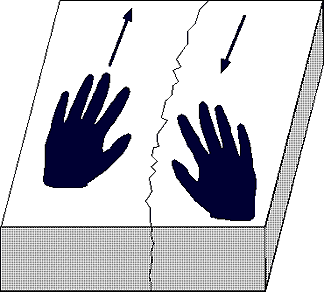 |
Try this little experiment:
Soon a little bit of foam rubber along the crack (the fault) will break and the two pieces will suddenly slip past each other. That sudden breaking of the foam rubber is the earthquake. That's just what happens along a strike-slip fault. |
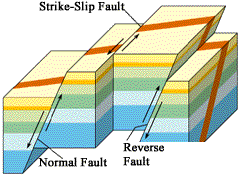
|
Types of Fault Slip. The usual fault model has a strike (direction from north of the horizontal line in the fault plane) and a dip (angle between direction of steepest slope and horizontal). The hanging wall lies over the footwall, the lower wall of an inclined fault. Relative offsets parallel to the strike produce strike-slip faulting while those parallel to the dip generate dip-slip faulting. Strike-slip faults are right or left lateral, depending on whether the block on the opposite side of the fault from the observer moves to his right or left. Dip-slip faults are normal if the hanging-wall block moves downward relative to the footwall block; the opposite motion produces reverse or thrust faulting. A mixed offset results in oblique-slip faulting, which is measured either by the plunge or by the slip angle. |
|
|
Intensity Scales The level of violence of seismic shaking varies considerably over the affected area. This intensity is not capable of simple quantitative definition and, particularly before seismographs capable of accurate measurement of ground motion were developed, the shaking was estimated by reference to intensity scales that describe the effects in qualitative terms. Subsequently, the divisions in these scales have been associated with accelerations of the local ground shaking. Intensity depends, however, in a complicated way not only on ground accelerations but also on the periods and other features of seismic waves, the distance of the point from the source, and the local geological structure. Furthermore, it is distinct from magnitude, which is a measure of earthquake size specified by a seismograph reading. |
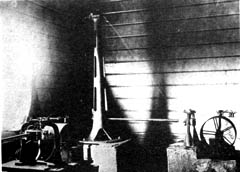 |
A Seismograph is an instrument that records the motions of the Earth's surface. A seismic monitoring station was set up on the hill top of the Coloane Island, with a set of Analog Seismograph at the beginning and later with an additional set of Digital Seismograph. Whenever an earthquake occurs, the seismic waves will be detected by the Seismograph, process by the amplifier, and will be transmitted to the Center via wireless or telephone lines. Although the first seismic instruments accurate enough to be used in the scientific study of earthquakes were invented by three Englishmen-- James Alfred Ewing, Thomas Gray, and John Milne--the instruments were created while the three men were working at the Imperial College in Tokyo, Japan. The seismic instruments that Ewing, Gray, and Milne invented were known as seismographs, a term still in use today. Seismographs use the principle of inertia to record the movement of the earth during an earthquake. Imagine a pendulum hanging by a string. When an earthquake occurs, the ground starts to shake. The pendulum, however, owing to its inertia, is at first motionless. By comparing the position of the pendulum with the position of the ground during an earthquake, it is possible to record the shaking of the ground. Although modern seismographs use complex electronics to record the ground shaking as accurately as possible, they still rely on the same basic concepts as the Ewing-Gray-Milne instruments. The figure below shows a Bosch-Omori seismograph, one of the early successors to the original Ewing-Gray-Milne seismographs in Japan. |
|
In the Spring of 1906 San Francisco was booming. Six years earlier, George Eastman introduced the first of the famous BROWNIE Cameras. It sold for $1 and used film which sold for 15 cents a roll. For the first time, the hobby of photography was within the financial reach of virtually everyone. Many had cameras, and many were taking pictures. It was a great new world, every photo taken was very likely a "first." Many of folks personal snapshots were quite good, even by modern standards.
The disaster of 1906 was not a great destruction of people - but a great destruction of materials, which helps explain the behavior of many survivors at the time. They did not panic - there was no mass hysteria. They were concerned and they were curious as to the extent of the damage. Some stood on the hills, some in the streets and others sat on the roofs and balconies drinking tea. Everybody was watching the fire. And many - VERY many - reached for their cameras and went out to take some pictures. An exact number is unknown, but hundreds, if not thousands of pictures were taken on that eventful day. 
Among those capturing the disaster on film was one of the worlds very best - Arnold Genthe - who borrowed a camera from a friend and went to work. Many of these masterpieces are now in the permanent collection of the Palace of Legion of Honor. The significance of the 1906 Earthquake becomes magnified by the fact that for the first time in history a major disaster occurred in a major city at a time when there was an abundance of cameras, film and photographers on hand to record it for future generations.
The earthquake devastated cities and towns along a 270 mile stretch of the San Andreas fault line from Fort Bragg, in the north, to Salinas in the south. Reports indicate that the quake shook buildings as far away as Sacramento, 100 miles from the epicenter. In San Francisco many buildings of poor construction were demolished and many homes were rocked off their foundations. Over 50 fires broke out in the downtown area within minutes of the quake. San Francisco's deputy fire chief, said rescue workers were overwhelmed. "It's not the quake that's caused the mess, it's the bloody fire. We're scattered all over the city trying to fight it. It'll be three or four days before we even get it under control." With broken gas lines feeding the fires, and broken water mains leaving little to no water available to fight the fires, an estimated 490 city blocks, over 25,000 of the city's buildings, would be destroyed, 250,000 people left homeless.
Collapse of the 4-story Valencia Hotel produced one of the greatest single tragedies of the earthquake. The exact number of dead will never be known, since fire swept through before rescue workers could get everyone out of the wreckage.
|
San Francisco 1906 Earthquake and Fire Books:
For those of you interested in some really great old fashioned reading material,
here are links to two of my favorite books about the 1906 earthquake.
|
The
Earth Shook, the Sky Burned |
|
If
You Lived At The Time Of The Great San Francisco Earthquake |
|
|
|
|
